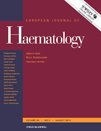A prospective cohort study on patients treated with anticoagulants for cerebral vein thrombosis
Abstract
Objectives
Cerebral vein thrombosis (CVT) is a potentially fatal disorder for which treatment guidelines are scanty. To assess the short- and long-term benefit of anticoagulant therapy, we performed a prospective cohort study on CVT patients.
Methods
Forty-four consecutive CVT patients received conventional anticoagulation with heparin followed by warfarin for at least 3 months. Patients presenting with symptoms suggestive of pulmonary embolism (PE) underwent confirmatory objective tests. Acquired or inherited risk factors for thrombosis were investigated in all patients. Thrombotic and hemorrhagic events occurring during treatment, and the long-term outcome using the modified Rankin Scale (mRS) were recorded.
Results
Congenital and/or acquired conditions predisposing to thrombosis were detected in 37 patients (84.1%), with a high prevalence of oral contraceptive use (66.7% of females) and thrombophilia (31.8%); more than one risk factor was seen in 31.8% of cases. At referral, six patients (13.6%) presented with symptoms of PE, which was confirmed in all. During the initial treatment period, two patients (4.5%) developed symptomatic progression of CVT, which was fatal in 1, and 2 (4.5%) developed major bleeding complications. A favorable outcome (mRS 0–2) at 6–12 months was recorded in 37 of the 43 patients who survived the acute phase (86%).
Conclusions
The outcome of CVT patients managed with conventional anticoagulation who survive the initial phase is favorable in the vast majority. The prevalence of concomitant PE is considerably high, supporting the need of anticoagulant therapy.




